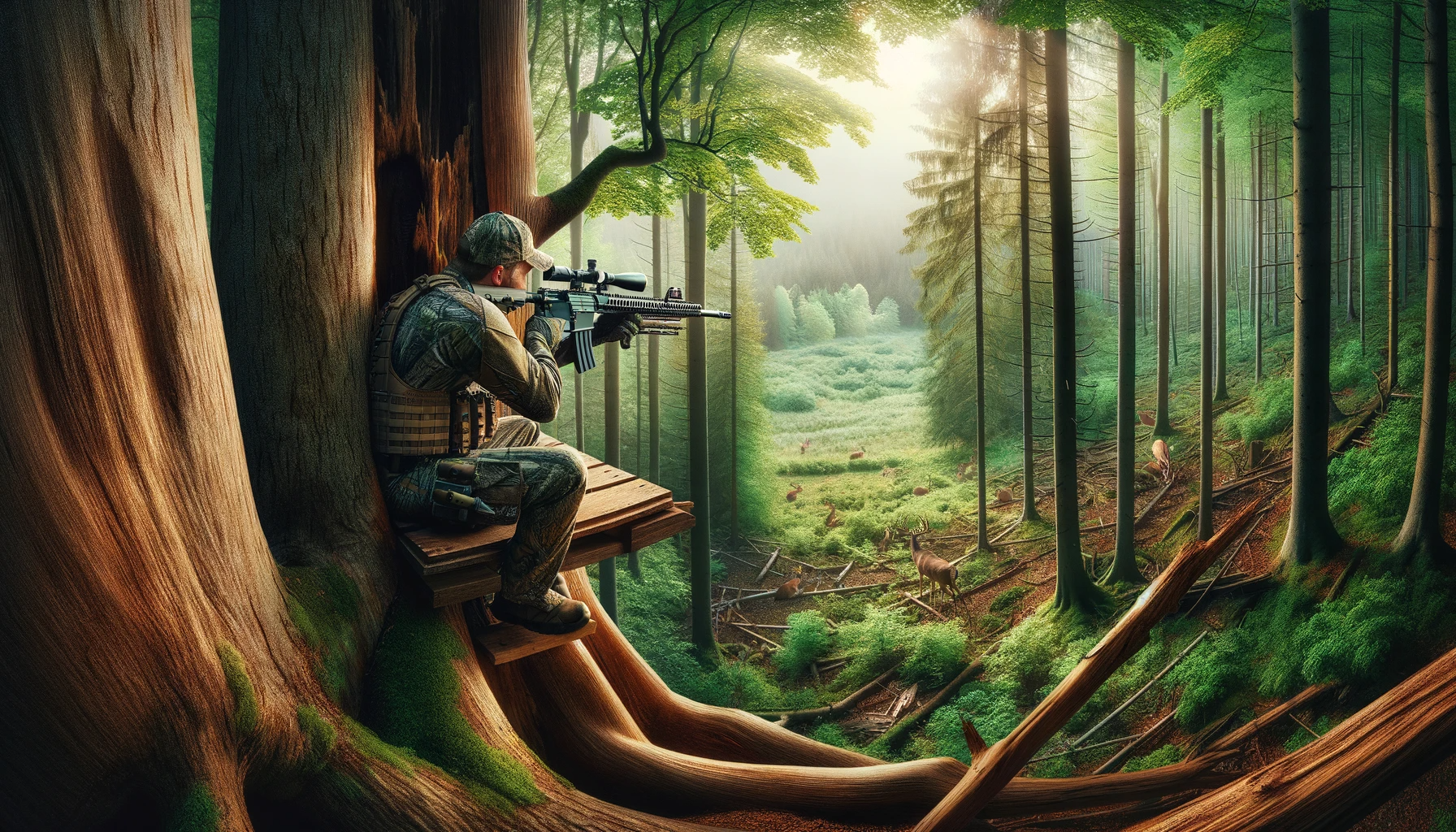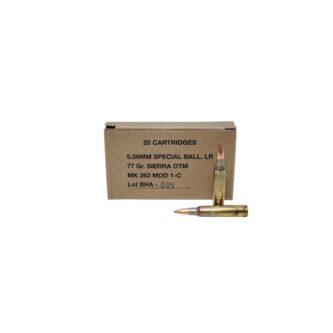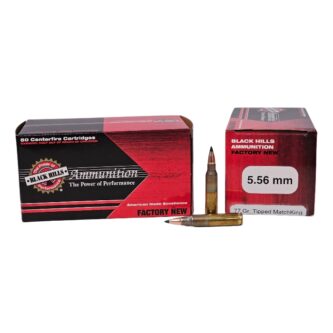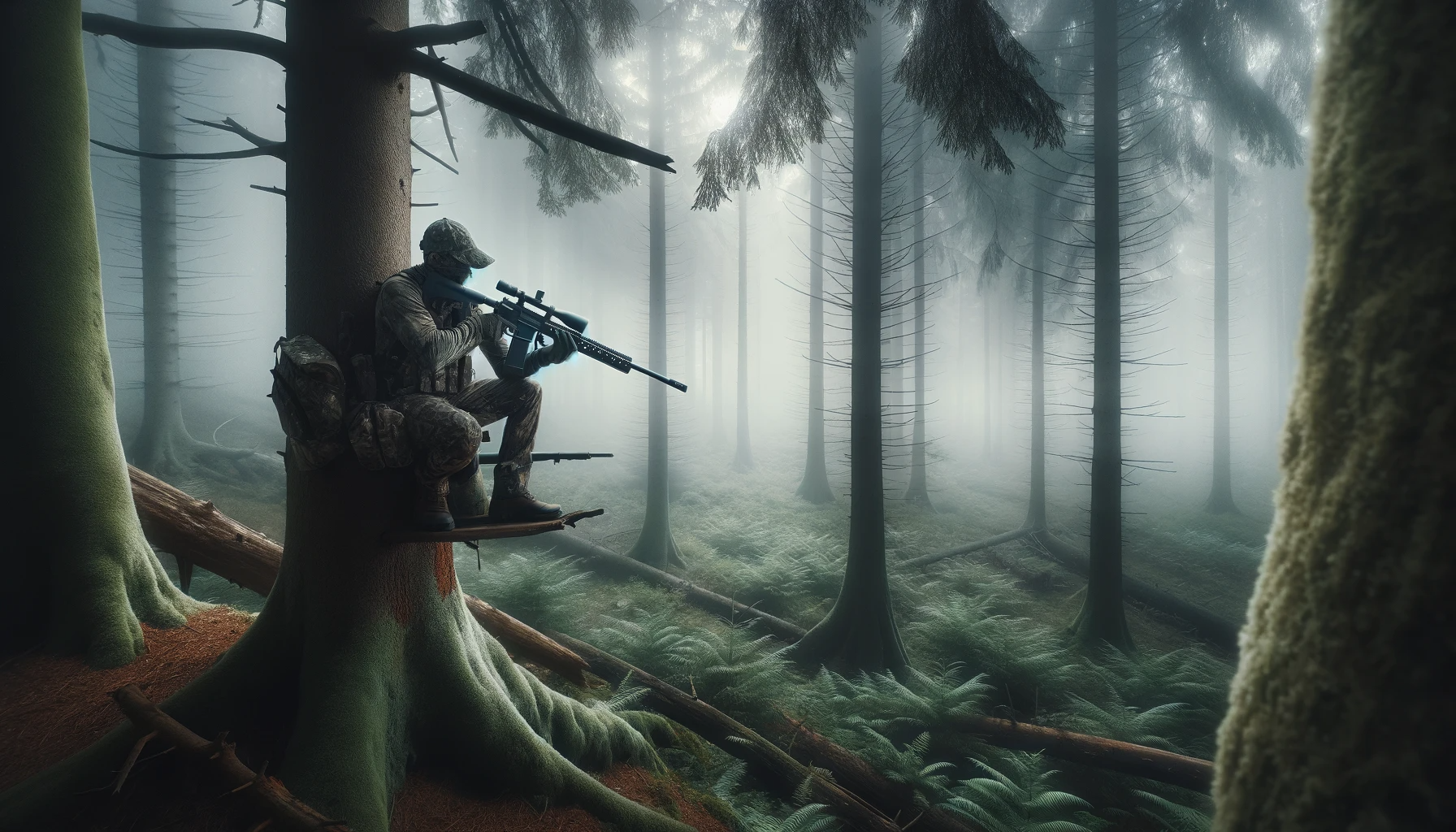A new trend is steadily gaining momentum in the world of deer hunting – the use of AR-15 rifles. Once primarily associated with tactical applications, the AR-15 has emerged as a favored tool among modern deer hunters, offering unmatched versatility and adaptability. This shift reflects a broader trend in hunting culture, where traditional practices meet modern innovation. Central to this evolution is the choice of ammunition, particularly the .223 and 5.56 calibers, which have become increasingly popular for their effectiveness in the field.
The .223 and 5.56 rounds, known for their precision and relatively light recoil, have proven to be more than capable for deer hunting, especially when used with the versatile AR-15 platform. These calibers offer hunters the perfect balance of power and manageability, making them ideal for a range of environments and scenarios. In this article, we delve into the reasons behind the growing preference for AR-15s in deer hunting, with a special focus on .223 and 5.56 ammunition. Whether you’re a seasoned hunter looking to switch to a more modern setup or a newcomer curious about this trend, our guide will shed light on the benefits and considerations of using these calibers for your next hunt.
Popular .223 and 5.56 Ammo for Deer
Understanding the AR-15 Platform for Hunting
The AR-15, a rifle originally designed for military use, has increasingly found favor in the hunting community, particularly among deer and medium-sized game hunters. This surge in popularity can be attributed to several key factors that make the AR-15 an appealing choice for hunting.
Versatility and Customization:
- The AR-15’s modular design is one of its greatest strengths. It allows hunters to customize their rifles according to their specific needs. Whether it’s swapping out barrels for different lengths or calibers, or adding accessories like scopes, bipods, flashlights, and slings, the AR-15 can be tailored to suit various hunting styles and preferences. These accessories can easily be added or removed depending on the situation and game being hunted. The rifles are also easy to clean and manage.
- Its lightweight and semi-automatic nature enable hunters to take quick follow-up shots, an advantage in scenarios where finishing the kill in a humane way is crucial.
Adaptability to Different Hunting Scenarios:
- The AR-15’s adaptability extends to various hunting environments. From dense woods to open fields, it performs reliably, offering accuracy and ease of handling. The rifle’s ergonomics ensure comfort during long hours of stalking or waiting for the perfect shot.
- For deer hunters, this adaptability means being able to engage at different ranges with precision. The AR-15, coupled with the right caliber like .223 or 5.56, provides sufficient stopping power for deer, making it a viable option for ethical hunting.
Growing Acceptance in the Hunting Community:
- Initially met with skepticism, the AR-15 has gradually earned its place in the hunting community. This acceptance is partly due to the growing recognition of its practical benefits, combined with advancements in ammunition that have enhanced its suitability for game like deer.
- Additionally, the AR-15 appeals to a new generation of hunters who appreciate the blend of traditional hunting with a more modern, customizable firearm experience.
The AR-15’s rise in the hunting world is a testament to its versatility, adaptability, and ability to meet the diverse needs of today’s deer hunters. As more hunters discover the advantages of this platform, it’s likely to continue gaining traction as a favored choice for various hunting scenarios.

Advantages of Using .223 and 5.56 Calibers
The choice of caliber is pivotal, and this is where the .223 and 5.56 rounds come into their own. These calibers, often used in AR-15 rifles, offer a range of benefits that cater well to the demands of deer hunting and are manufactured by a variety of high quality ammo brands. .223 and 5.56 calibers offer a compelling combination of accuracy, range, and manageability, making them increasingly popular choices for deer hunting. Their suitability for this purpose is a testament to the evolving nature of hunting equipment and the adaptability of hunters to new techniques and technologies.
Accuracy and Precision:
- One of the standout features of both .223 and 5.56 calibers is their accuracy. These rounds are known for their consistent performance and ability to maintain a straight trajectory over long distances.
- The precision of these calibers is particularly beneficial in deer hunting, where a clean, humane shot is paramount. The accuracy ensures that hunters can target vital areas more effectively, leading to a quick and ethical harvest.
Effective Range:
- While traditionally considered calibers suited for medium-range engagements, advancements in ammunition technology have extended the effective range of both .223 and 5.56 rounds.
- This extended range capability means that hunters using these rounds can confidently take shots at distances that were once considered too far for these calibers, expanding their hunting grounds and opportunities.
Lightweight and Manageable Recoil:
- The .223 and 5.56 rounds are lighter compared to some of the larger calibers traditionally used in deer hunting. This lighter weight contributes to less fatigue when carrying ammunition and allows for more agile movement in the field.
- Additionally, these calibers are known for their manageable recoil. This feature is especially advantageous for hunters who are sensitive to recoil or for younger hunters still acclimating to the sport. The reduced recoil also aids in maintaining accuracy, particularly for follow-up shots.
Suitability for Deer Hunting:
- When it comes to deer hunting, the effectiveness of a caliber is often measured by its ability to ethically and efficiently take down the game. The .223 and 5.56 rounds, when used with proper shot placement and the right bullet type, are more than capable of humanely harvesting deer.
- The key to maximizing these rounds in deer hunting lies in choosing the right ammunition. Bullets designed for hunting, such as soft points or polymer-tipped bullets, enhance the round’s effectiveness, ensuring adequate penetration and energy transfer.
Choosing the Right Ammunition
Selecting the right ammunition is as crucial as choosing the firearm itself, especially when it comes to deer hunting. For those using .223 and 5.56 calibers, understanding the nuances of different bullet types, weights, and their ballistic performances is key to a successful hunt.
Understanding Bullet Types:
- Soft-Point Bullets: Ideal for deer hunting, soft-point bullets offer a good balance between penetration and expansion, ensuring the bullet transfers enough energy to the deer for an ethical kill.
- Polymer-Tipped Bullets: These bullets provide higher accuracy and a more controlled expansion upon impact, making them suitable for deer hunting, especially at longer ranges.
Bullet Weight Considerations:
- The weight of the bullet is a significant factor in determining its trajectory and terminal performance.
- For .223 caliber, bullet weights from 55 to 77 grains can be effective, but heavier bullets (62 grains and above) are generally preferred for their better stability and knockdown power.
- In 5.56 caliber rifles, using bullets in the 55 to 77-grain range is also effective, with the choice depending on the range and specific hunting conditions.
Ballistic Performance:
- Ballistics, or the science of how a bullet behaves in flight, is crucial in determining the effectiveness of your ammo.
- Both .223 and 5.56 calibers are known for their flat trajectories, which is a plus at medium ranges. However, understanding how your chosen bullet weight and type perform at various distances will aid in making more accurate shots.
- It’s also essential to consider the twist rate of your rifle’s barrel as it affects the stability and, consequently, the accuracy of the bullet.
Match the Ammo to Your Hunting Environment:
- For hunters in dense forests or bushy areas, a heavier bullet that can maintain its path and energy after cutting through foliage might be preferable.
- In open fields or plains, a lighter, faster bullet could be more suitable for longer shots.
When choosing your ammunition, remember that practice and familiarity with your chosen rounds are just as important as their specifications on paper. Spending time at the range and understanding how your ammo behaves in different conditions will significantly enhance your hunting experience.
Recommended .223 and 5.56 for Deer Hunters
Ballistics and Performance
The effectiveness of ammunition in hunting is largely determined by its ballistic characteristics. For deer hunters using .223 and 5.56 rounds, understanding these ballistics is key to making successful and ethical shots. Let’s delve into the performance of these calibers and how they translate into deer hunting scenarios.
Ballistics of .223 Rounds:
- Trajectory: The .223 caliber, known for its flat trajectory, allows for accurate shooting at moderate distances. This characteristic is particularly advantageous in open terrains where long-range shots are common.
- Energy: While the .223 is on the lower end of the energy spectrum for deer hunting, with proper bullet selection, it can deliver enough energy for a clean shot on a deer, especially at ranges within 200 yards.
- Penetration: The penetration ability of .223 rounds can vary based on bullet type and weight. Heavier bullets, like 62 grains or more, tend to penetrate deeper, making them more suitable for deer hunting.
Ballistics of 5.56 Rounds:
- Trajectory: The 5.56 caliber shares similar flat trajectory characteristics with the .223, making it effective for accurate shooting at range.
- Energy: Generally, 5.56 rounds offer slightly more energy than .223 rounds due to their higher chamber pressure. This increased energy translates into better performance for deer hunting, especially at ranges up to 300 yards.
- Penetration: Like the .223, the penetration of 5.56 rounds depends on bullet design and weight. 5.56 ammunition is typically loaded with bullets designed for more penetration, making them effective for larger game like deer.
Comparing Performance in Deer Hunting Ranges:
- .223 for Shorter Ranges: The .223 caliber is more than capable for deer hunting at shorter ranges. It is ideal for wooded or brush-covered terrains where shots are typically taken at shorter distances.
- 5.56 for Longer Ranges: The 5.56 caliber, with its slightly higher energy and penetration, is better suited for open areas where shots may be taken at longer distances.
- Bullet Choice: Regardless of caliber, choosing the right bullet type is crucial. For both .223 and 5.56, using expanding bullets like soft-points or polymer-tipped bullets is recommended to ensure sufficient energy transfer and appropriate wounding capabilities.
Both .223 and 5.56 calibers can be effective for deer hunting, provided that hunters choose the right ammunition and understand the limitations and strengths of each caliber. Familiarity with their ballistic profiles and practicing at various ranges can greatly increase the chances of a successful and responsible hunt. You can shop all of our 5.56 ammo and .223 ammo with confidence because at KIR Ammo customer service, fast shipping, and quality products are our forte.
.223 and 5.56 Cartridges are Great Choices for Medium-Game Hunting
The AR-15’s rise as a popular platform for deer hunting reflects a broader trend towards versatility and adaptability in hunting equipment. The .223 and 5.56 calibers, with their precision, manageable recoil, and effective range, align perfectly with the AR-15’s characteristics, offering hunters a reliable option for various hunting scenarios. We discussed the importance of choosing the right type of ammunition, taking into account factors such as bullet weight, type, and ballistic performance, which are critical for ensuring ethical and effective hunting. The ballistics analysis of both calibers underscored their suitability for different hunting ranges, with the .223 being more apt for shorter distances and the 5.56 excelling in longer-range scenarios.
As hunters, it’s our responsibility to ensure that our practices are ethical and sustainable. This responsibility extends to our choice of ammunition – selecting the right caliber and bullet type not only enhances our hunting experience but also ensures humane and ethical harvesting of game.
We invite you to shop .223 and 5.56 ammunition at KIR Ammo where customer service and fast shipping on ammo is standard. Whether you’re a seasoned hunter or new to using an AR-15 for deer hunting, we have a variety of bulk ammunition that will work for your situation. Don’t forget to check out the ammunition we have on sale. We’d love to hear from you – share your experiences, tips, or stories about deer hunting with AR-15s in the comments. Your insights not only enrich our community but also help fellow second amendment enthusiasts make informed decisions. Happy hunting, and may your next outdoor adventure be both successful and rewarding!
FAQ for .223 & 5.56 Deer Hunting Cartridges
Q: What 5.56 ammo is best for deer hunting?
A: For deer hunting, 5.56 ammo with heavier grain bullets (such as 62-grain or higher) and expanding bullet types like soft-point or polymer-tipped bullets are recommended for their effective energy transfer and stopping power.
Q: Why is 5.56 banned for hunting in some places?
A: In certain jurisdictions, 5.56 is banned for deer hunting due to concerns about its stopping power and ethical harvest. Regulations vary, so it’s crucial to check local hunting laws.
Q: What is the best AR-15 caliber for deer hunting?
A: While .223 and 5.56 are popular, calibers like the .308 Winchester or 6.5 Grendel are often considered better for deer hunting due to their higher energy and broader range effectiveness.
Q: Is 7.62 or 5.56 better for deer?
A: The 7.62 caliber typically offers more stopping power than 5.56, making it a preferable choice for deer hunting, especially for larger deer and at longer ranges.
Q: Will 5.56 drop a deer?
A: Yes, a 5.56 round can drop a deer, especially if using appropriate bullet types and shot placement. However, it’s essential to consider the ethical implications of ensuring a quick and humane harvest.
Q: Is 5.56 effective for deer hunting?
A: 5.56 can be effective for deer hunting within its appropriate range and with proper bullet selection, although it’s generally more suited for smaller game.
Q: Why is a .223 not good for deer hunting?
A: The .223 is often debated for deer hunting due to concerns about its stopping power and range limitations, making it less suitable for larger deer or longer shots.
Q: What is the best barrel length for 5.56 hunting?
A: A barrel length of 16-20 inches is generally considered best for 5.56 hunting, providing a good balance between maneuverability and ballistics performance.
Q: Is it better to hunt with 223 or 556?
A: The choice between 223 and 556 for hunting depends on the game size and hunting conditions. The 5.56 may offer slightly better performance due to its higher velocity and pressure.



